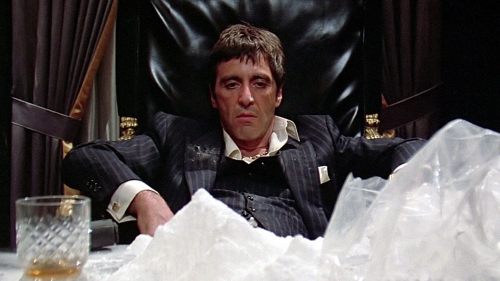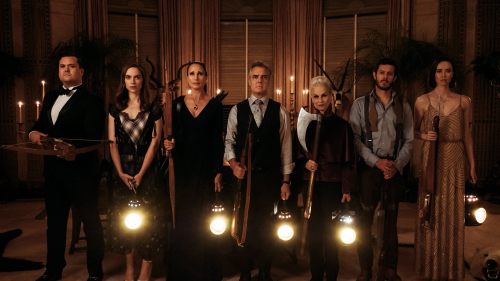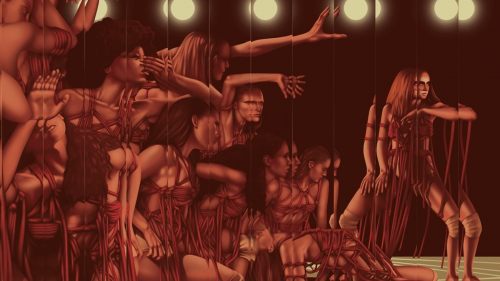Constructing A Coven: SUSPIRIA’s Production Design Casts A Horrifying Spell
Warning: this post contains spoilers for Suspiria.
“There’s more in that building than what you can see, Doctor.”
When it was announced that a remake of Dario Argento’s Suspiria was in the works, audiences were skeptical to say the least. His giallo technicolor masterpiece appeared untouchable. Who would dare attempt to produce a rendition of such an iconic piece of cinema? Well, director Luca Guadagnino stepped up to the plate and delivered a war-torn and timely adaptation (or rebirth, if you will) choosing to preserve the core plot of the film but strip away the brightly-colored gothic fairytale created by Argento. The visual aesthetic of Suspiria is one of its defining elements, and while the reception for Guadagnino’s retelling has been polarizing, a lot of careful consideration went into the production design in order to provide a richer historical background, one which captures not only the battered streets of Berlin in 1977 but the internal conflict of a coven and women coming into their own.
Both films are set in Cold-War Germany. The time period is far from a colorful scene, but each contains abundant horrors in their own right. The era marked a desolate point of destruction consumed by the German Autumn, and Argento utilized its violence and devastating emotional effects as a conduit for escapism through vibrant lighting and architecture. Cinematographer Luciano Tovoli created his own language of color and lighting, stating he “decided to intensively utilize primary colors - blue, green, and red - to identify the normal flow of life, and then apply a complementary color, mainly yellow, to contaminate them.” Tovoli emphasized that “a [horror] film brings to the surface some of the ancestral fears that we hide deep inside us, and Suspiria would not have been the same cathartic function if I utilized the fullness and consolatory sweetness of the full color spectrum.”

In contrast, Guadagnino embraces the period’s turmoil and darkness by employing bleak hues and withered structures. The vibrancy of the original is therefore replaced with subdued hues of blue, green, and brown to represent the relentlessly oppressive atmosphere. Guadagnino and production designer Inbal Weinberg (Three Billboards Outside Ebbing Missouri, The Place Beyond the Pines) borrow design cues from notable masters of modernist architecture such as Le Corbusier and Adolf Loos while constructing a set with two principal layers: the politically turbulent world outside and the witchy world within. Guadagnino set his sights on the Grand Hotel Campo dei Fiori located on top of a mountain in Varese, Italy, an Art Nouveau-era 200-room hotel built in 1910, but whose last visitors checked out in 1968. Its towering structure and decrepit interior were the perfect fit for the home of his coven residing within the prestigious Helena Markos Dance Academy (above). The building itself is reminiscent of the Looshaus, one of Adolf Loos’ most famous structures completed in 1911. Weinberg decided to conceptualize the building's location to reside in the West Berlin neighborhood of Kreuzberg. She then applied green and white cipollino marbling to the exterior facade, and erected a fabricated portion of the Berlin wall outside the academy’s domineering front door. The hotel served as a filming location for the dance studios, offices, kitchen, the dancers’ dormitories, Madame Blanc’s apartment, and the secret underworld of the Mutterhaus (or “mother house”) containing the curious cabinet of occult relics, the dark catacombs, and the ritual chamber known as the “Room of Feasts”. Weinberg designed each room of the academy with its own unique purpose and decor to properly reflect both the history and subterfuge of the coven.

Upon entering the academy, there is a grand lobby (above) with ceilings high enough to comfortably swallow its visitors whole. Six hundred and thirty-two faux floor tiles were layered down with a black arrow design. The direction in which the arrow motifs appear on screen supports the notion that Susie Bannion was drawn to the academy all the way from her home state of Ohio. They also reflect Madame Blanc’s inspiration behind her new dance, Volk, as she conveys the performance is representative of rebirths and “the inevitable pull they exert and our efforts to escape them”. Their directional flow leads to the dance studio on the upper floor. The room’s pale pink walls symbolize a young, feminine innocence as Susie rehearses under the careful eye of Madame Blanc, slowly harnessing her power and embracing her untapped role as a leader of the coven. Weinberg recruited historic Austrian glassware brand Lobmeyr to install a series of 1960s-style glistening chandeliers (originally designed for the New York Metropolitan Opera) to hang above the dancers’ heads. Their decorative presence emphasizes the different time periods the building and the coven have survived, while also adhering to a mode of modernism. The motif of sharp angles, arrows, and directional flow continues on the back wall of the studio, but now point downward, gravitating and pulling the dancers to the dark underworld below. This is further exemplified by Susie’s magnetic draw to the floor in her primal dancing and physical movements projecting a sense of distorted yearning, as if trying to crawl out of her own skin and begin anew.

Ornate items and motifs are also on display within Madame Blanc’s opulent apartment (below). In the jet-black-lacquered dance room adjacent to her living room, Weinberg commissioned a custom rug from the esteemed French company La Manufacture Cogolin. Woven into its thread count is a geometric pattern that was symbolically created for the witches and hidden throughout the film. Weinberg’s claw motif also appears in posters on the door to the dance studio before being fragmented into a kaleidoscopic carpet in Madame Blanc’s personal studio and living room. Walls are upholstered with a textured silver, reminiscent of the ceremonial tape on the dance floor and angular claw marks courtesy of an Italian fabric brand Dedar; the same textiles that Guadagnino utilized to decorate the 17th century villa in Call Me By Your Name.

Throughout history, witches have typically been perceived as sinister women bent over steaming black cauldrons filled with menacing concoctions. Weinberg, however, transformed this stereotype by mixing both traditional and modern nuances in form and function. The idea was to convey that the witches have been around for so long that their dwelling contains furniture from various decades. Their kitchen is modeled after the Frankfurt kitchen, one of the first mass-produced fitted cooking spaces designed in 1926 by Austrian architect Margarete Schütte-Lihotzky while also drawing inspiration from the 1933 Sonneveld House located in Rotterdam, Netherlands. Despite several rooms of the academy being grand and luxurious, the kitchen serves as a congregation space to vote on authoritative roles, as well as perform the relatable mundane tasks of the day such as drinking coffee and reading the paper.

Certain rooms in the Mutterhaus are specifically meant to invoke dark magic. The “Room of Shelves”, for instance, contains antique relics in a cabinet of curiosities, complete with expensive china and sadistic silver hooks displayed like trophies. The “Room of Feasts” (above) is the space in which the Black Sabbath occurs. Guadagnino instructed the production team to weave hemp-fiber braids into sculptural, hairlike masses meant to adorn the ritual chamber, while three large dresses hung in the background to represent the three mothers. Conceptually, the walls are meant to be textured with the hair of their victims. Susie, Madame Blanc, and Olga all have significantly long hair which could serve as a sacrificial theme as they each relinquish a part of themselves at one point or another. Additionally, in the beginning of the film, Patricia reiterates to Dr. Klemperer that the witches took her hair, while Susie’s dreams show long hair on the ground covering hands clawing a wooden floor. This room also displays a gloriously gory amount of bloodshed (enough to literally paint the walls red) as Susie transforms into Mother Suspiriorum. The blood symbolizes her transition to womanhood (or motherhood, in this sense), deviating from her sexually repressed youth and innocent dancing days within the tender pink walls of Markos’ studio. The “Room of Compartments” embodies a storage chamber for the coven’s victims. In an interview with Deadline, Weinberg dissects the room’s structure and influences complete with pentagram windows, coffin beds made for the homeless during Victorian England, images painted by surrealist artist Alfred Kubin, and threaded material inspired by contemporary artist Chiharu Shiota to depict a “menacing cocoon” meant to preserve individuals for sacrifice.
The extensive historical and cultural research painted into the production design and visual aesthetic alone is vastly engrossing. Guadagnino’s storytelling surpasses script and plot by moving into the physical construction of a world that is brutal yet beautiful. Weinberg’s talents also enrich a thematically dense narrative that encompasses the spectrum of femininity, political upheaval, and artistic homages, all exemplified through a coven of witches. Madame Blanc tells her dancers, “when you dance a dance of another, you make yourself in the image of its creator.” It’s clear that Luca Guadagnino’s Suspiria possesses nostalgic adoration for Argento’s original, but thanks to his talented team of designers, his reimagining is able to take center stage all on its own.



